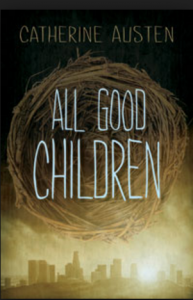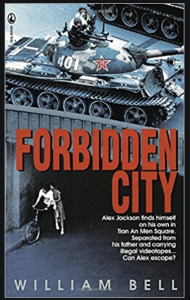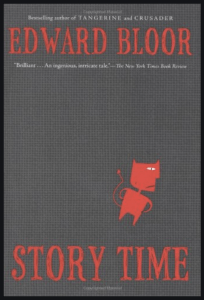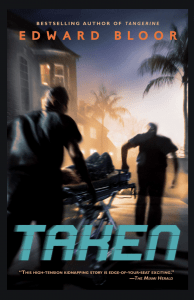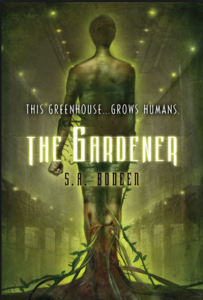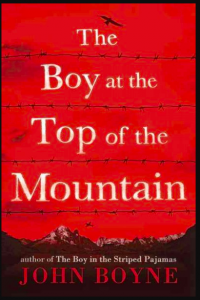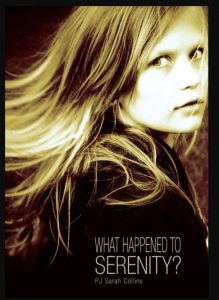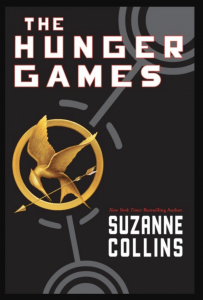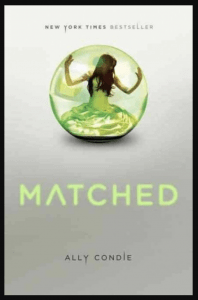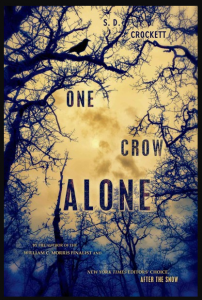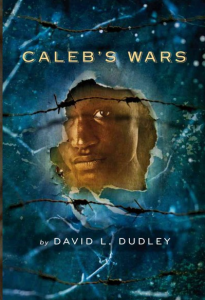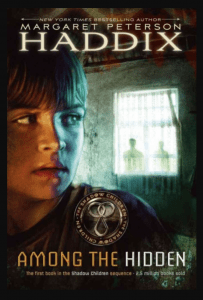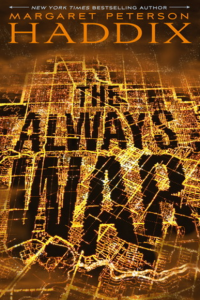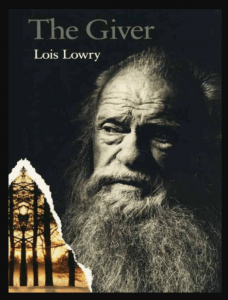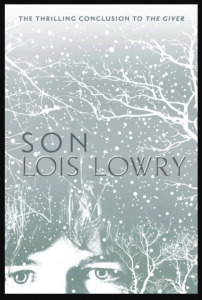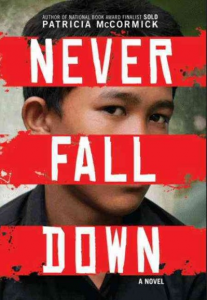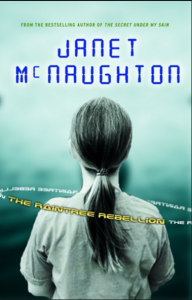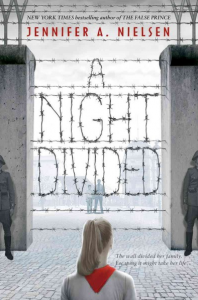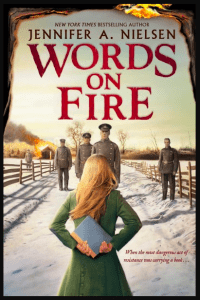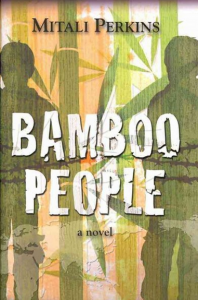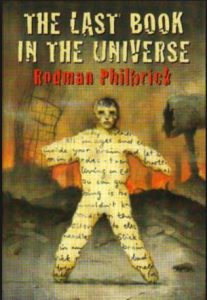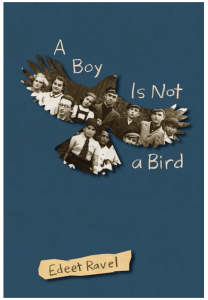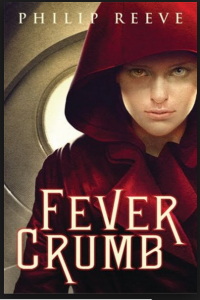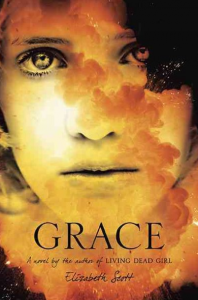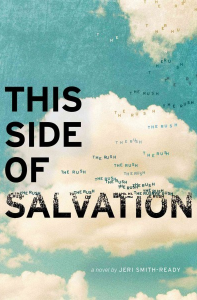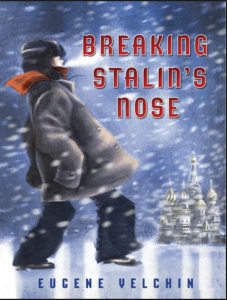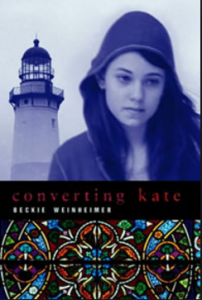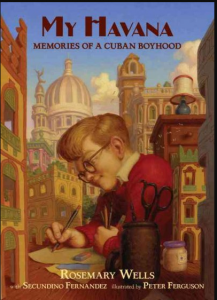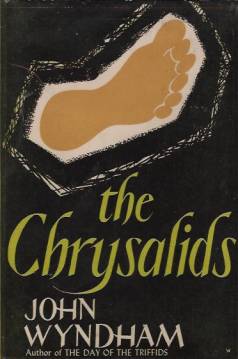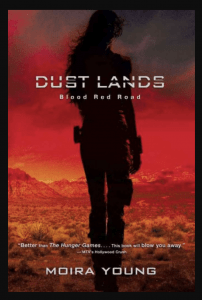Societies of control
are found in historical fiction, fantasy novels and dystopian science fiction novels.
Anthony, Joelle. Restoring Harmony. New York: G.P. Putnam’s Sons, 2010.
“Ten years after the Great Collapse of 2031, sixteen-year-old Molly McClure, with only her fiddle for company, leaves the safety of her family’s island home to travel through a dangerous and desolate wasteland on her way to Oregon to find her grandparents and persuade them to return with her to Canada.” – CIP The quality of the writing is uneven, but the entertaining plot line will keep the attention of readers who enjoy futuristic novels. Recommended for 11 to 16-year-olds. [British Columbia; Dating (Social customs); Friendship; Environmental degradation; Gangs; Grandparents; Individuality; Musicians; Oregon; Science fiction; Survival; Voyages and travels]
Austen, Catherine. All Good Children. Victoria: Orca, 2011.
Max is trying to evade the authorities and survive in a world where everyone must instantly obey, children are given drugs to make them obey, and consequences for misbehaviour are immediate and severe. [Schools; Friendship; Brothers and sisters; Single-parent families; Science fiction; Family life; Runaways; Young adult fiction]
Avi. Catch you Later, Traitor. Toronto: Tundra Books, 2015.
Twelve-year-old Pete Collison enjoys reading detective novels and listening to radio dramas. But in 1950s America, the government’s search for communist sympathizers leads to a real-life mystery when the FBI shows up at Pete’s home in Brooklyn, New York. Could there be Communist spies in his family? A note at the end of the story provides more information about this time in American history, describing the author’s connections to his own life growing up in New York City. A fast-moving suspenseful novel highly recommended for readers 11 years old and up.
Bell, William. Forbidden City. Doubleday Canada, 1990.
Forbidden City by William Bell (Doubleday Canada, 1990) is a story about a sixteen-year-old boy named Alexander, enthusiastic and out-going, with a fascination for war-related strategies and important generals. One of his favourite hobbies is making soldiers out of clay. When his father goes to China, he is excited to go along but that’s when a dilemma happens. He is caught in a student protest and has to choose whether to help the students – and risk being hurt, wounded, or killed by the government armies – or to run and flee from the soldiers. He gets caught and sent back to America where he writes Forbidden City to cope with his pain. (Caleb in grade eight)
Bloor, Edward. Story Time. New York: Harcourt, 2004.
George and Kate are selected to attend a special school that is proud of itself for having the highest test scores in the country. But what is lost when daily testing and constant pressure replace joyful learning? Mystery, suspense, and humour all combine in this engaging novel suitable for readers 12 years old and up. [Schools; Family life; Eccentrics and eccentricities; Corruption; Ghosts; Humorous stories]
Bloor, Edward. Taken. New York: Alfred A. Knopf, 2007.
In 2036, wealthy Americans live behind security gates in fear of being kidnapped, and transmitters are surgically implanted into their children so they can be found if they are kidnapped. Armed guards escort children to and from school. In this science fiction suspense story, Charity tries to follow the instructions she has been taught in order to survive when she is snatched in the middle of the night. An engrossing novel for readers 12-years-old and up. [Fathers and daughters; Florida; Kidnapping; Poverty; Science fiction]
Bodeen, S.A. The Gardener. New York: Square Fish, 2010.
“When high school sophomore Mason finds a beautiful but catatonic girl in the nursing home where his mother works, the discovery leads him to revelations about a series of disturbing human experiments that have a connection to his own life.” – CIP. Could be compared to Gem-X. [Fathers; Runaways; Science experiments; Secrets; Single-parent families]
Boyne, John. The Boy at the Top of the Mountain. Toronto: Doubleday Canada, 2015.
When Pierrot is four years old, his father – a German soldier in the Great War – disappears. When Pierrot is seven years old, his French mother dies in a Parisian hospital. What will happen to Pierrot? He is sent to live with his Aunt Beatrix, a housekeeper for Adolf Hitler. It is 1935 and life is changing in Europe.
What happens when people flatter us and make us feel important? What happens when lies start to sound like truth? What happens when we realize we’ve betrayed the people who love us?
Spanning the course of World War II and its aftermath, this 215-page novel by a breathtakingly powerful writer is highly recommended for mature readers 11-years-old and up. [France; Germany; Historical fiction; Hitler, Adolf; Orphans; Self-awareness]
Cass, Kiera. The Selection. HarperTeen, 2012.
Sixteen-year-old America lives in a future world formed after the destruction of the United States. She is chosen to compete in a contest to win the heart of the nation’s prince but wants, instead, to be with the young man she really loves. While the writing is somewhat stilted, the story will likely be appreciated by readers who enjoyed Matched by Condie. [Marriage; Contests; Princes; Love; Science fiction]
Collins, P. J. Sarah. What Happened to Serenity? Markham, ON : Red Deer Press, 2011.
Katherine lives in an isolated austere world. Everyone obeys the leader. No one asks questions. Except Katherine. And she is punished but she does not stop questioning and searching until she finds another world outside her bleak community. Set in the Canadian prairies, this story could be compared to many futuristic dystopian novels but has a surprising twist at the end which will leave readers with questions about our present-day world. Who can we trust? What is more important: safety or independence of thought? What is the role of the media in a free society? An easy-to-read novel, quickly paced, recommended for readers in grade 5 and up. [Courage; Family life; Friendship; Government; Saskatchewan; Science fiction; Values]
Collins, Suzanne. The Hunger Games. Scholastic, 2008.
I recently read an awesome book called The Hunger Games by Suzanne Collins (Scholastic, 2008). This story takes place in an alternative future in which the United States is a nation of 12 districts. The main character is a young teenage girl, Katniss, whose father has died and so now she is responsible for her family of two: her sister and mother. Even though she is only a 16-year-old girl, she is a tough hunter who puts food on her family’s table. Katniss is very brave and will do anything to help her family. Every year, two tributes are chosen from each district to participate in the cruel Hunger Games. When Katniss’s sister Pam gets chosen to participate in these life or death games, Katniss steps up and decides to take her place. The second tribute who is chosen is the baker’s son, Peeta, who is attracted to Katniss. Katniss and Peeta fight together for survival in the arena! But how will they act when they need to kill each other? Read this thrilling novel of the Hunger Games to find out! (Simran)
Collins, Suzanne. Catching Fire. Scholastic, 2009.
Catching Fire by Suzanne Collins (Scholastic Press, 2009) is the story of Katniss who already won the Hunger Games along with Peeta. Katniss, who has to go back into the Hunger Games once again, faces a conflict: save herself and let Peeta die or sacrifice herself in order to save Peeta. Because Katniss decides to save Peeta, she is very protective of him and suspicious of everyone’s intentions. Once the games begin, though, she notices something strange: it seems as if everyone is trying to protect Peeta. Katniss soon finds out that the other contestants are trying to escape to District 13, a district supposedly blown off the map years ago. This book was very suspenseful and original. I think it would appeal to kids in grade eight or higher who enjoy science-fiction novels. (Chelsea in grade eight)
Catching Fire by Suzanne Collins (Scholastic Press, 2009) was a very well-written novel. Often, I found it felt as though I was in the book. It would seem like I could hear the cannons firing, anxiety filling my mind as I awaited names of the dead, warmth leaving my bones as a storm poured upon the moist soil beneath my feet. At one point in the book, near the end, I actually felt fear as a sudden explosion nearly killed the main character. I could imagine the light beige sand against the grey-blue saltwater segment of the giant clock-like map. I am eagerly anticipating the third book in this trilogy. I really want to know what happens after the uprising and revolution that occurred in Catching Fire. (Jonathan in grade eight)
Condie, Ally. Matched. Dutton Books, 2010.
Cassie has to choose. Will she follow the rules of her perfect society or will she follow the desires of her heart? Set in a futuristic society, this novel could be compared to Gem X by Nicky Singer. Set in a world where adults determine children’s futures, it could also be compared to Payback by Rosemary Hayes and The Giver by Lois Lowry. First in a series.

Couloumbis, Audrey. War Games. New York: Random House Children’s Books, 2009.
This novel, based on a true story, describes life for twelve-year-old Petros when German soldiers invade his Greek village during World War 2. Quarrels with his older brother Zola fade away when a Nazi commander takes up residence in their small home and they must quickly hide all belongings that might betray their American background. Games of marbles give way to a greater challenge: how to hide their older cousin who has escaped German custody. Masterfully told by a Newbery Honor author, this story will engage readers eleven years old and up. It might especially appeal to readers of The Boy in the Striped Pajamas. [Greece; Historical fiction; World War 2; Brothers; Farm life; Secrets; Courage; Cousins]
Crockett, S.D. After the Snow. New York: Square Fish, 2013.
“Fifteen-year-old Willo Blake, born after the 2059 snows created a new ice age, searches for his family, who mysteriously disappeared from their frozen mountain home, and encounters outlaws, halfmen, and an abandoned girl along the way” – CIP. [Climatic changes; Survival]
Crockett, S.D. One Snow Alone. New York: Feiwel and Friends, 2013.
“The long, bitter winters are getting worse, and a state of emergency has been declared across Europe. In Poland, the villagers are subject to frequent power cuts and fuel shortages. After the death of her grandmother and the evacuation of her village, 15-year-old Magda joins forces with the arrogant, handsome Ivan and smuggles her way onto a truck bound for London – where she hopes to find her mother. But London, when they reach it, is a nightmarish world, far from welcoming.” – CIP Highly recommended for ages 12 and up. [Climatic changes; Survival]
Dudley, David L. Caleb’s Wars. New York: Clarion Books, 2011.
Caleb, a black fifteen-year-old in rural Georgia, has to step off sidewalks and into the mud to get out of the way of white people. He can wash dishes in the kitchen of a restaurant but may not sit down at a table to eat. Those are the rules. But when German prisoners of war receive more respect than black people, Caleb decides to break the rules. [Fathers and sons; Georgia; Racism; World War 2; Black Americans; Prisoners of war; Germans; Segregation; Faith]
Ellis, Deborah. The Breadwinner. Vancouver: Douglas & McIntyre, 2000.
Because the Taliban rulers of Kabul, Afghanistan, impose strict limitations on women’s freedom and behavior, eleven-year-old Parvana must disguise herself as a boy so that her family can survive after her father’s arrest. (OhioLINK) There are two more books in this series: Parvanna’s Journey and Mud City.
Galante, Cecilia. The Patron Saint of Butterflies. New York: Bloomsbury Pub., 2008.
“When her grandmother takes fourteen-year-old Agnes, her younger brother, and best friend Honey and escapes Mount Blessing, a Connecticut religious commune, Agnes clings to the faith she loves while Honey looks toward a future free of control, cruelty, and preferential treatment.” – FVRL. [Christian life; Communal life; Connecticut; Cults]
Haddix, Margaret Peterson. Among the Hidden. Simon & Schuster Books for Young Readers, 1998.
In this first book in the Shadow Children series, twelve-year-old Luke has lived his entire life in hiding because of a law that families may only have two children. But when he meets another third child, he starts to question the government edict that forbids his existence. On the ERAC recommended novel list for grades 6 to 8. First of a series.
Haddix, Margaret Peterson. The Always War. New York: Simon & Schuster Books for Young Readers, 2011.
Tessa has only known war. All her life, her country has been at war. But then she meets Gideon and they go on an adventure together and they discover that perhaps there is no war. Perhaps everyone has been believing a lie. While not the most compelling novel of this genre, Haddix’s brisk action-filled story can nevertheless be enjoyed by readers eleven-years-old and up. [Science fiction; Runaways; War; Computers; Airplanes]
Hughes, Monica. Devil on My Back. Methuen, 1984.
What if you didn’t have to study for tests or practise to learn new skills? What if a computer programme could simply be inserted into your brain and you would know everything you needed to know? But what if a programme was inserted that made you unquestionably obey any orders? Would you really be able to enjoy freedom?
Hughes, Monica. The Tomorrow City. Metheun, 1978.
Caroline and David try to escape from a computer-controlled city which seeks to control all the inhabitants, as well.
Lowry, Lois. The Giver. Yearling, 1993.
In this Newbery Medal Book, Jonas becomes the receiver of memories and discovers the terrible secrets of his society. On the ERAC recommended list for grades 5 to 7. First in a series.
The Giver by Lois Lowry (Yearling Newbery, 1993) is about Jonas, a curious gifted boy who has been give the highest honour of his community the Receiver of Memory. In a place of Sameness, no colours and no pain, nor love, it is hard being one of the only people to be different, see colours and know both pain and love. This is the troublesome way Jonas has to live after he is selected for this position. Not being allowed to mention any of this to anyone, not even his own family, Jonas begins to wonder why their ancestors chose to begin a life where everyone is blind to true feelings and wisdom. With all these joyless judgments building up inside him, he is left with only two choices: run away and live a life where everyone is unique and there is love or stay imprisoned, physically and mentally. If he chooses to leave, he will be a failure to the community, just as the previous Receiver was ten years ago. But does that even matter if it’s the right way to go? Our lives today are like that in many ways. We know that whatever we do, others may think it is wrong even if it’s the right way. If we don’t, we won’t ever be happy hiding behind all our secrets and unknown wisdom. To find out what Jonas chooses to do, read The Giver and see if he makes the same choice you would. (Ilar in grade eight)
The Giver by Lois Lowry (1993 Bantam Books) takes place in an unknown city and unknown time. Pretty boring, huh? It tells the story of Jonas who is reaching the age of 12. In his unknown city, there is a town meeting to tell all the 12-year-olds what their assigned jobs are, but when it comes to Jonas’s turn, he gets skipped. Later, though, he is called to the city hall and the mayor tells him he will be the next Giver. This story is not so boring, at all! Jonas is sent to a building where a man named The Giver tells him he is special and then puts his hands on him. Suddenly, Jonas pictures a man on the ground with his legs blown off. Jonas jumps away. He asks what that was. The Giver tells him it was a memory of a war. The next day, Jonas goes back and the Giver gives another memory but this time he is on sand and is basking in warm sunshine. And now The Giver tells him what his new job will entail: he has to keep all the memories of the city so that no one has memories of the real world. What does this mean? After, the Giver gives Jonas all the memories – all the painful and all the bad – and tells him to leave. Jonas goes over a hill and sees a fury of colour all over the place. There are two other books in this series which I haven’t read yet, but based on the amazingness of this book, I can predict that they will be very good. (Jake in grade eight)
Lowry, Lois. Gathering Blue. Boston : Houghton Mifflin, 2000. [Second in a series.]
Lowry, Lois. Messenger. Boston : Houghton Mifflin, 2004. [Third in a series.]
Lois Lowry. Son. Boston : Houghton Mifflin, 2012. [Fourth in a series.]
[Young adult fiction; Mothers and sons; Voyages and travels; Good and evil]
McCormick, Patricia. Never Fall Down. New York : Balzer + Bray, c2012.
Arn is forced to serve as a child soldier in this vivid novel, based on a real story, by an accomplished author. It will be appreciated by mature readers in grades eight and up. [War; Survival; Cambodia; Soldiers; Genocide; Young adult fiction; Kidnapping]
McNaughton, Janet. The Raintree Rebellion. Toronto: HarperTrophy Canada, 2006.
Eighteen-year-old Blake and her adopted mother return to Toronto in a future world that is struggling to survive after a technocaust. While her mother works on a justice council, Blake discovers that a microchip in her arm holds surprising and unwelcome information. This sequel to The Secret Under My Skin is a compelling and believable novel for 12 to 17 year olds. [Toronto, (Ont.); Science fiction; Identity; Secrets; Environmental degradation; Terrorism]
Nielsen, Jennifer A. A Night Divided. New York: Scholastic Press, 2015.
When the Berlin Wall went up, Gerta, her mother, and her brother Fritz are trapped on the eastern side where they were living, while her father, and her other brother Dominic are in the West–four years later, now twelve, Gerta sees her father on a viewing platform on the western side and realizes he wants her to risk her life trying to tunnel to freedom.” – CIP. Highly recommended for readers 11 to 16-years-old. [Berlin Wall; Courage; Germany; Secrets; Tunnels]
Nielsen, Jennifer A. Words on Fire. New York: Scholastic Press, 2019.
“In 1893 twelve-year-old Audra lives on a farm in Lithuania, and tries to avoid the Cossack soldiers who enforce the Russian decrees that ban Lithuanian books, religion, culture, and even the language; but when the soldiers invade the farm Audra is the only one who escapes and, unsure of what has happened to her parents, she embarks on a dangerous journey, carrying the smuggled Lithuanian books that fuel the growing resistance movement, unsure of who to trust, but risking her life and freedom for her country.” – CIP. A 322-page historical novel highly recommended for readers 11 years old and up. [Books and reading; Historical fiction; Lithuania; Russia; Smuggling]
Perkins, Mitali. Bamboo People. Watertown, Mass.: Charlesbridge, 2010.
Chiko has been forced to join the Burmese army.Tu Reh has run away from a refugee camp to join his father fighting with the Karen people against the Burmese government. The two boys unexpectedly meet in the jungle. What will happen? This young adult novel of compassion and hope set in Myanmar is recommended for readers 12-years-old and up, especially ones who appreciated War Brothers by Sharon McKay and Shattered by Eric Walters. [Fathers and sons; Burma; Survival; Soldiers; Refugees; War stories; Courage]
Philbrick, Rodman. The Last Book in the Universe. New York: Blue Sky Press, 2000.
Spaz has heard about a world with books, but he has never seen one. In his world, people use mindprobes, needles which shoot pictures straight into your mind and let you escape the grey misery of life. But then he meets an old man, Ryter, and learns the power of stories. For readers who liked The Hunger Games or Fahrenheit 451, this thoughtful but easy-to-read novel. [Science fiction; Fathers and sons; Adventure and adventurers; Epilepsy; Books and reading]
Ravel, Edeet. A Boy Is Not a Bird. Toronto: House of Anansi Press/Groundwood Books, 2019.
Eleven-year-old Natt’s comfortable life comes to an end when Russian soldiers invade his eastern European town during the summer of 1940. Hebrew schools are closed. Markets are shut down. Homes are confiscated. At first, Natt tries to cheerfully adjust to the Soviet occupation. But when food becomes scarce, his father is arrested, and he and his mother are put on a cattle train headed for Siberia, his perspective changes. He recalls his father’s words: During a war, every day you can stay alive, you are a hero. Based on the true story of the author’s fifth grade teacher, this vivid 221-page novel is highly recommended for mature readers 11 years old and up.
P.S. Readers of Breaking Stalin’s Nose by Eugene Yelchin may wish to compare how the two main characters – Natt and Sasha – both stop admiring Stalin after their fathers are inexplicably arrested.
Reeve, Philip. Fever Crumb. New York : Scholastic, 2009.
Foundling Fever Crumb has been raised as an engineer although females in the future London, England, are not believed capable of rational thought, but at age fourteen she leaves her sheltered world and begins to learn startling truths about her past while facing danger in the present.” – CIP Recommended for competent readers 11 – 16 years old. [England; Foundlings; Identity; Science fiction; Technology]
Scott, Elizabeth. Grace. New York: Dutton, 2010.
“Sixteen-year-old Grace travels on a decrepit train toward a border that may not exist, recalling events that brought her to choose life over being a suicide bomber, and dreaming of freedom from the extremist religion-based government of Keran Berj.” – FVRL. [Despotism; Fantasy fiction; Fugitives from justice; Runaways; Trust]
Singer, Nicky. Gem X. Holiday House, 2006.
When 16-year-old Max discovers cracks in his face, he also discovers that he is the subject of an experiment by his scientist father. Can human beings be genetically altered so that they will not age? What will happen to the subjects if that experiment fails? And what other experiments are being conducted?
Smith-Ready, Jeff. This Side of Salvation. New York: Simon Pulse, 2014.
“After his older brother is killed, David turns to anger and his parents to religion, but just as David’s life is beginning to make sense again his parents press him and his sister to join them in cutting worldly ties to prepare for the Rush, when the faithful will be whisked off to heaven.” – FVRL. This 368-page novel is highly recommended for competent readers 13-years-old and up. [Cults; Faith; Families; Grief; Pennsylvania; Schools]
Stead, Rebecca. First Light. New York: Wendy Lamb Books/Random House, 2007.
“When twelve-year-old Peter and his family arrive in Greenland for his father’s research, he stumbles upon a secret his mother has been hiding from him all his life, and begins an adventure he never imagines possible.” – CIP A more hopeful story that focuses on relationships rather than technology. Highly recommended for readers 11 to 15 years old. [Adventure and adventurers; Extreme environments; Friendship; Greenland; Polar regions; Science fiction]
Velchin, Eugene. Breaking Stalin’s Nose. New York: Henry Holt, 2011.
When I was a child, my father told me a story of his childhood on the Canadian prairies during the hungry years of the 1930s. A man in his village said that life would be far better for them if they lived in the Soviet Union where everyone had enough food to eat. “Go then,” people said in my father’s village. And he did. He moved to Russia. Some time later, he sent a letter to Canada. “Come here! There are enough jobs and enough food for everyone. Come. But you will need a very sturdy trunk for such a long journey. There is only one place in the village that makes the kind of trunk you will need.” And he gave the name of the business. It was the casket maker.
This novel, a Newbery Honor book, tells the story of ten-year-old Sasha who adores his father who works for the secret police in Stalinist Russia. But his perspective changes when he discovers secrets about his deceased mother and his father is unexpectedly arrested, leaving Sasha homeless in the middle of winter. While easy to read, this powerful story is best suited for brave readers aged eleven and up.
Weinheimer, Beckie. Converting Kate. New York: Viking Childrens Books, 2007.
“After moving from Arizona to Maine, sixteen-year-old Kate tries to recover from her father’s death as she resists her mother’s dogmatic religious beliefs and attempts to find a new direction to her life.” – FVRL. This novel about religious control presents various religious views and is recommended for readers in grades 8 to 12. [Faith; Family problems; Friendship; Gay teenagers; Grief; Moving, Household; Maine; Schools; Self-perception]
Wells, Rosemary with Secundino Fernando. My Havana: Memories of a Cuban Childhood. Somerville, Mass.: Candlewick Press, 2010.
“Relates events in the childhood of architect Secundino Fernandez, who left his beloved Havana, Cuba, with his parents, first to spend a year in Spain, and later to move to New York City.” – CIP. Full colour illustrations and black and white photographs accompany this story of the architect’s childhood, the only children’s book I’ve found that depicts the political situation in Cuba during the reign of Batista and the turmoil as Castro gained power in 1959. Highly recommended for all readers 9 years old and up. [Architecture; Dictators; Cuba; Family life; Fernandez, Secundino; Historical fiction; Spain]
Wyndham, John. The Chrysalids. Penguin, 1955.
Set in Labrador, Canada, far in the future, this classic novel describes a society in which anyone not conforming to strict physical standards is killed, sterilized or banished. But Sophie, who hides her six-toed feet, and David, who has telepathic skills, become friends and start to question this culture that considers them to be “Blasphemies”. CIP.
Yelchin, Eugene. Breaking Stalin’s Nose. New York: Henry Holt, 2011.
This novel, a Newbery Honor book, tells the story of ten-year-old Sasha who adores his father who works for the secret police in Stalinist Russia. But his perspective changes when he discovers secrets about his deceased mother and his father is unexpectedly arrested, leaving Sasha homeless in the middle of winter. While easy to read, this powerful story is best suited for brave readers aged eleven and up. [Communism; Fathers and sons; Homelessness; Russia; Secrets]
Young, Moira. Blood Red Road. New York: Margaret K. McElderry Books, 2011.
” In a distant future, eighteen-year-old Lugh is kidnapped, and while his twin sister Saba and nine-year-old Emmi are trailing him across bleak Sandsea they are captured, too, and taken to brutal Hopetown, where Saba is forced to be a cage fighter until new friends help plan an escape.” – CIP Written in present tense, this intense dystopian novel will be appreciated by more competent readers.

